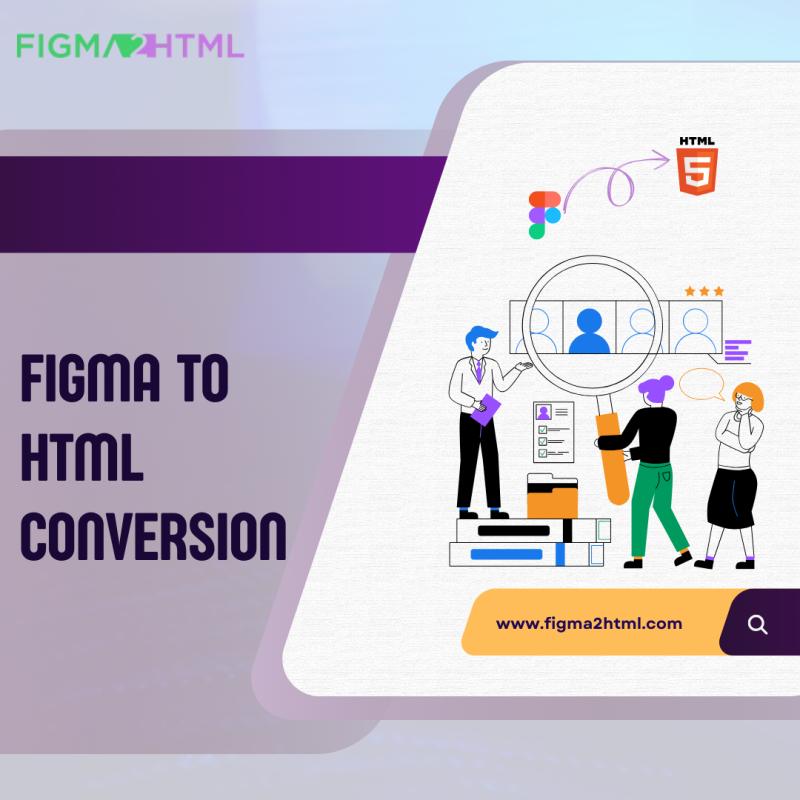The Role of Figma to HTML in Modern Web Development

In the fast-paced world of modern web development, the efficiency of design-to-development workflows is paramount. As technology evolves, so do the tools that web designers and developers use to create stunning, functional websites. One of the most crucial steps in this workflow is translating design concepts into real, working code. Figma to HTML conversion has emerged as a key process that bridges the gap between a design prototype and a fully functional web page.
Figma, a collaborative design tool, has become the go-to platform for UI/UX designers due to its cloud-based nature and intuitive interface. However, as powerful as Figma is for creating beautiful, high-fidelity mockups, it cannot produce the HTML code needed to render those designs on the web. To turn Figma designs into a live, interactive website, the designs need to be converted into HTML, CSS, and JavaScript.
This article will explore the role of Figma to HTML conversion in modern web development, the process involved, and why it is essential for both designers and developers to leverage this tool for faster, more efficient, and accurate web design workflows.
The Importance of Figma in Modern Design
Before diving into the Figma to HTML conversion process, it’s important to understand why Figma has become the tool of choice for so many designers. Unlike traditional design tools like Sketch or Adobe XD, Figma operates in the cloud, allowing real-time collaboration between team members. This feature is particularly helpful for teams working remotely or in different time zones, enabling them to collaborate and make changes on the fly without worrying about version control or file compatibility.
Figma’s versatility goes beyond simple wireframing or designing static elements; it allows for the creation of interactive prototypes, animations, and user flows that can simulate real-world interactions. This means that stakeholders—designers, developers, clients, and project managers—can experience the design before development begins, ensuring that there are no surprises later in the process.
Despite all these advantages, the designs created in Figma remain as static visual assets. To create a functioning website, these designs need to be translated into HTML code, making the Figma to HTML conversion process crucial in modern web development.
Why Figma to HTML Conversion Matters
The process of converting Figma designs into HTML code is an essential part of the web development workflow. It ensures that a design is translated accurately into the final product, saving developers time and reducing the likelihood of errors during the development phase.
1. Speeding Up the Development Process
One of the primary reasons Figma to HTML conversion is so valuable is the speed it adds to the development process. Traditionally, a designer would hand off static design files (usually in .PSD or .AI format) to a developer, who would then have to manually code the HTML, CSS, and JavaScript from scratch. This can be a time-consuming and error-prone process.
By converting Figma designs into HTML code directly, designers can speed up the handoff process, reducing development time and allowing the website to go live much faster. This is especially important for businesses that need to launch new websites or features quickly to stay ahead of competitors.
2. Accuracy and Consistency
Designers put a lot of effort into making sure every detail of a design is pixel-perfect, but when the design is passed off to developers, there’s always a risk of discrepancies between the design and the final product. The process of convert Figma to HTML ensures that every element in the design is translated accurately into the corresponding HTML code, maintaining the integrity of the design.
Automated Figma to HTML conversion tools help maintain consistency across different screens and devices, which is particularly important for responsive web design. With responsive design becoming the standard, ensuring that the design is properly implemented for various screen sizes is essential for delivering an optimal user experience.
3. Collaboration Between Designers and Developers
The Figma to HTML process enhances collaboration between designers and developers, enabling them to work together more seamlessly. Figma itself allows for real-time collaboration, but the conversion process takes it a step further by ensuring that both parties are working with the same visual reference in mind. Developers don’t have to guess or interpret the design—they can work directly from the code generated from the Figma design.
Moreover, Figma to HTML conversion tools often allow for the generation of clean, organized code that’s easier to understand and modify. This reduces the potential for miscommunication between the designer and developer and ensures that both teams are on the same page when building the final product.
4. Reduced Errors and Rework
One of the most frustrating aspects of web development is rework. A developer might spend hours coding the HTML for a webpage, only to realize that some aspect of the design was overlooked or misinterpreted. This not only wastes time but can lead to delays and frustration for everyone involved.
By automating the Figma to HTML conversion process, the chances of these types of errors are significantly reduced. Since the process generates code directly from the design files, the risk of human error is minimized. Additionally, when using automated conversion tools, the generated code is often structured in a way that follows best practices, reducing the need for refactoring or rework.
How the Figma to HTML Conversion Process Works
Converting Figma designs into HTML code is a multi-step process. While manual conversion is still possible, many developers and designers opt to use automated tools or services to speed up the process and improve accuracy. Below is an overview of how the Figma to HTML process typically works.
1. Exporting Assets from Figma
The first step in the convert Figma to HTML process is to export the necessary design assets from Figma. These can include images, icons, logos, and other visual elements that will be used in the final website. Figma allows designers to export assets in various formats such as PNG, JPEG, SVG, or PDF.
In this step, it's important to ensure that all assets are optimized for the web. For example, images should be compressed to reduce their file size without sacrificing quality, and vector graphics like logos should be exported as SVG files for scalability.
2. Converting Figma Designs to HTML Code
Once the assets are exported, the next step is to convert the design elements into HTML code. This involves creating the structure of the web page (HTML) and applying the appropriate styles (CSS) to match the design in Figma. This is where tools and plugins that support Figma to HTML conversion come in.
Some tools allow you to generate the HTML and CSS directly from your Figma file, which can then be fine-tuned for responsiveness and interactivity. In other cases, developers may manually write the HTML and CSS based on the Figma design while using the exported assets.
There are also various Figma to HTML conversion services that can do this for you, offering clean, responsive, and optimized code that’s ready to be implemented.
3. Ensuring Responsiveness
In today's web development environment, responsiveness is a must. The HTML and CSS generated from Figma need to be tested across multiple devices to ensure that the layout and content adapt to different screen sizes. This includes smartphones, tablets, laptops, and desktops.
The Figma to HTML conversion process often includes setting up responsive breakpoints and media queries to ensure that the design scales properly on various devices. Testing and debugging the responsive behavior is critical to ensuring the design is fully functional across different platforms.
4. Adding Interactivity and Animations
Figma designs often include animations and interactive elements that simulate user actions, such as button clicks, hover effects, and page transitions. These interactions are typically designed using Figma’s prototyping features but must be implemented with code in the final product.
Developers can use JavaScript or libraries like jQuery to add the desired interactions and animations based on the design prototype created in Figma. This can include hover effects, dynamic content loading, and other user-driven actions that enhance the user experience.
Tools and Services for Figma to HTML Conversion
While Figma to HTML conversion can be done manually, many developers and designers prefer to use specialized tools and services to streamline the process. Some of the popular options include:
Figma Plugins: There are several Figma plugins available that can help convert designs into code. Plugins like "Figma to HTML" or "HTML Generator" allow users to quickly generate HTML and CSS code from their designs. These plugins can save time and improve accuracy by automating part of the conversion process.
Figma to HTML Services: There are also services, like Figma2HTML, that specialize in converting Figma designs into clean, responsive HTML code. These services offer end-to-end solutions, including design-to-code conversion, optimization for performance, and support for responsive layouts.
Custom Conversion Tools: Some development teams create custom tools that integrate with Figma's API to automate the Figma to HTML process according to their specific needs. These tools may be designed to work with certain frameworks or include additional features, such as automatic image compression or integration with content management systems (CMS).
Conclusion
The Figma to HTML conversion process plays a critical role in modern web development by enabling faster, more accurate translation of design prototypes into functional websites. As the demand for faster development cycles, responsive designs, and seamless collaboration between designers and developers increases, the importance of this process continues to grow.
By leveraging Figma to HTML conversion tools, developers can streamline their workflow, minimize errors, and ensure that the final product is true to the original design. Whether you choose to convert Figma to HTML manually, use Figma plugins, or rely on specialized services like Figma2HTML, the goal is always the same: to deliver high-quality, functional websites in the shortest time possible.
By embracing the power of Figma and modern Figma to HTML conversion techniques, businesses can build better websites, improve user experiences, and stay competitive in an ever-evolving digital landscape.


Comments (1)
Mohd Bilal7
Nice information, It will help wed developers to understand this topic